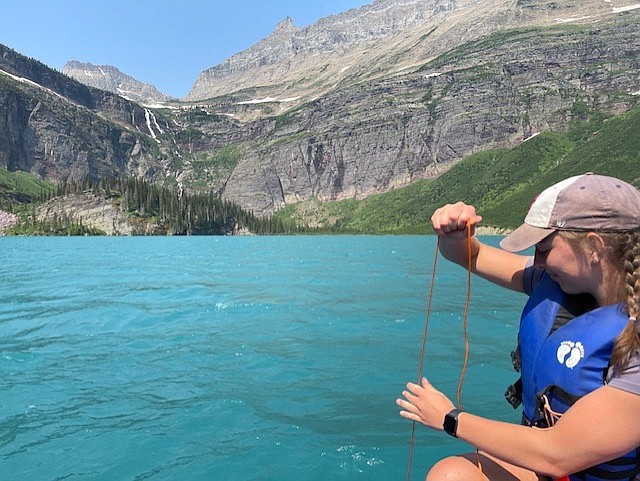Deep Dive into FLBS: Getting to the Bottom of Echo Lake
I can’t say what specifically ignited my interest when I opened that email containing a recent FLBS research publication announcement—whether it was because I’d never thought to connect the two parties involved, or if it was because I just so happened to open the email the Monday morning after the Super Bowl (complete with all of the nacho and hot wing gastrointestinal consequences implied therein).
Whatever the reason, as I read through the research paper I was struck by the connection between collaborative teamwork and the presence of devastating gas...
Okay, maybe that Super Bowl hangover is lingering because we’re not off to a great contextual start here. Let’s try this again:
Last summer, FLBS intern Abigail Ross embarked on an investigation into methane gas detected in Echo Lake. Echo Lake is a groundwater-fed pothole lake in the Flathead Valley near the quaint village of Bigfork. In the lake’s deepest layer of water, right near the bottom, there are extremely low oxygen levels, creating what is known as an anoxic environment. In this anoxic layer, methane has emerged. This raises a couple of questions: Where is the methane coming from, and what is preventing the methane from migrating to the shallower depths of Echo Lake?
Methane is a gas not commonly abundant in Montana lakes. The reason for its relative absence is that methane is not typically formed in waters with high levels of oxygen. Here in Montana, where we are renowned for incredible water quality, our lakes and rivers are excellent at not only providing high levels of oxygen for fishes and other aquatic organisms, but also keeping the presence of methane at bay.
Thanks to the help of microbes, whenever methane does emerge in our waters, it reacts with oxygen to become carbon dioxide and water rather than sticking around in its original methane form. In fact, when FLBS scientists conduct water quality monitoring, they carefully watch for decreases in oxygen near the bottom of lakes. Any decreases—known as “oxygen sags”—are a concerning sign of deteriorating water quality. When our water quality is high, you can safely bet that our microbial communities are doing their important work.
With FLBS Aquatic Microbial Ecology Professor Matt Church and FLBS post-doctoral researcher Logan Peoples serving as co-mentors, Ross led a genomic analysis of the microbial community located near the bottom of Echo Lake to determine what types of microbes reside there. Utilizing samples taken by undergraduate students enrolled in Church’s Microbial Ecology summer class, Ross worked alongside FLBS researchers Peoples and Evan Bilbrey to identify five different types of microbes that inhabit the anoxic layer near the bottom of Echo Lake.
The results of these identifications, which were recently published in the American Society for Microbiology’s Microbiology Resource Announcements, revealed that the microbes detected by Ross and her supporting team of researchers use methane as a food source. This explains why methane is found only at the bottom of Echo Lake. The tiny little organisms are consuming the gas before it can permeate its way toward the surface.
As for where the methane is coming from, the mystery remains. Ross and her colleagues did not identify any microbes known to produce methane, which suggests that the methane in Echo Lake is not being created by the biological community living in the lake. It’s more likely that the methane is percolating up from the sediments at the lake’s bottom, but researchers can’t say for sure. As is often the case with science, more studies are needed before any definitive conclusions can be made.
Nevertheless, for Ross to help advance our understanding of the methane in Echo Lake is no small achievement. Publishing a scientific paper as an undergraduate student is a major accomplishment. Most scientists do not publish until they are graduate students or professional scientists. Publishing discoveries that were made during a brief summer undergraduate internship is even more impressive. This work is especially exciting to me because it serves as a prime example of how the entire Bio Station community works together to protect Montana’s freshwater ecosystems.
It begins with the funders, those philanthropic donors who supported both Ross’s internship as well as scholarships for undergraduate students taking FLBS summer classes, and the grant from the National Science Foundation that paid for lab analyses, supplies, and research hours. Next are the summer students themselves who collected samples and important data during their coursework that resulted in a significant scientific discovery.
There are also the FLBS scientists who brought technical expertise to the study, like Bilbrey, who was an FLBS summer intern himself back in 2019 before being hired as an FLBS researcher, and mentors Peoples and Church, who provided time, insight, and guidance to see the research project through. Finally, there is Abigail Ross, the intern who took full advantage of her FLBS opportunity and made a real-world impact on the Flathead Watershed.
This kind of teamwork will never gain the attention and admiration of the masses the way teams do in a globally-televised football game. But the efforts are no less important and the stakes are even higher. After all, our lives and livelihoods depend on our healthy waters. It’s crucial that we do all we can to keep them pristine.
So, the next time you make your way out to the Bio Station, feel free to stop by my office. Help yourself to the towering piles of nachos and platters of spicy hot wings that I always have on standby, and join me in celebrating the Bio Station’s remarkable team. Sure, we may encounter a little dangerous gas along the way. But sustaining our waters is an effort worth cheering and, thanks to the collaborative crew here at FLBS, I’ve got one of the best seats in the house.

